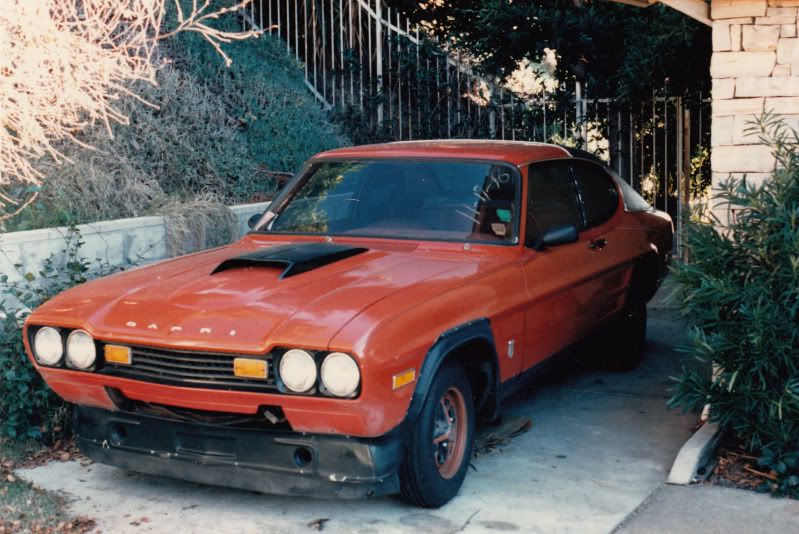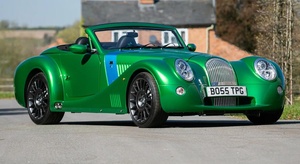I have been a Grassroots motorsporter in different forms since like 1989 (radiocontrolled cars then). When I first saw the magazine GRM something like 10 years ago, it instantly struck a string with me. But living in Sweden, it has been hard getting copies of it. Last year, my sister in law (who lives in Oakland CA) gave me a subscription for my xxth birthday. A very good present, and I soon started following the forum as well as the printed words. I also had the pleasure to meet some of GRM crew at the SEMA show in 2010.
Now I feel mature enough to introduce a thread on my build. It started in 1997 so this will be a retrospective thread, I hope you can endure that.
But before we go into that, some information about myself to "frame" the project. I grew up in and around classic Fords (well, back then they were not so classic, mostly just older cars), my dad had a couple of Cortina GTs and my uncle did some racing in Anglias and a Cortina GT with a Cortina Lotus engine. After I was born my dad went into more mundane daily drivers, at first a 1969 Cortina DeLuxe (1600 X-flow), we had a 1970 Cortina Auto and then a couple of Taunuses.
When I got my licence I "borrowed" my mums 1982 Taunus 2.0 L VIP for a couple of months, before I bought my first own car. It was a 1972 Granada Coupé, 2.3L V6 and GXL spec. It was a wonderful car but a bit scarred by life when I got it. To be honest I wasn't too kind to it (it was a cheap car, I was a poor student) and the V6 was always a bit thirsty. But oh how I liked the car. Things would have to change though and as I was in Prague of all places I stumbled over a MkIII Capri in an alley. I knew I had to have one - actually, I had known that since 1986 when I read about the X-pack kitted turbo MkIII that late Milan Knezevic built.
I went back home from Prague and basically bought the second Capri I found. It was a 1980 2.0S, red (not original colour), some issues but pretty cheap. I had to have it. It would not be a happy relationship for long though, I got the car in June and in November it was smashed to pieces by a guy who hit my left wing at 40 mph. I couldn't afford to fix the Capri but saved the wheels and the head at least.
During university years I ran around in a cheap Escort MkII (oxymoron these days!) and a 1979 Taunus auto. The Escort was a right wreck, the Taunus pretty solid.
As I graduated and got a job it was time for a Capri again. This was 1997, back then you still could find Capris advertised in the newspapers in Sweden, often enough that I could be a bit picky. It had to be a MkIII, it had to be a 2.0S, it should be running and it had to speak to my senses. I looked at numerous (that's how I recall it now at least, probably 4-5 cars) Capris that ticked all the boxes but the last one.
While looking at one option I realized I was quite close to another car for sale. It was advertised as a project, no engine but fresh paint, nice parts. I decided to take a look and suddenly the emotions were right. I can't say if it was the Recaros, the 7x13" 4-spoke Revolutions, the nice exhaust manifold or the seller with a geniune Capri interest. But I needed to have THAT Capri. My parents were not all that impressed by played the role of supporting parents and helped me drag it home.

Let me explain what I got. A 1974 1600 XL, but fitted with MkIII 2.0S panels, interior and drive line. According to the seller, the car had been modified in the early 80's the first time, and then it had been ran with different spec Pintos, chased by the police, took a beating, built back up, raced again and so on. Some years ago he decided to fix the worst parts but ran out of money when the paintjob was done. So it was sat in a garage, looking sorry for itself, and the he just lost spirit. The good parts were the wheels, the Recaros, the fixed bodywork, nice exhaust, stiffer suspension and spare Pinto head with a fast road cam and rejetted carb. Bad parts? No engine block, some scars in the fresh paintjob from sitting in garages. The front screen was cracked, the carpet missing and since most of the car was in boxes - a bit hard to judge the rest. But hey, even back then, for 5000 SEK (roughly £ 450-500) what could you expect.
My plan was a nice daily driver and I will explain how I quickly derailed from that plan...
I picked the car up in April (technically before I graduated) and I spent the summer trying to get the car back together. Sorting through the boxes was an interesting task.

An engine was found and dragged into the garage too.

Summer went along, we sorted some small rust holes in the floor and generally gathered the missing pieces. I found a faultless MkII grille and a Richard Grant rear spoiler at a scrapyard - lucky find, I don't think I paid £ 20 for it all :-) Otherwise the car went together fairly standard, apart from white dials and the alloys from my scrapped Capri.
The main target was to get the car through the MOT, I had gotten a job up north in Sweden and had a deadline when the car would have to move me and some stuff the 800 kilometres north. Me and deadlines is a bit of a delicate matter - I rarely miss them completely, most often I just hit them but sometimes I shift them a bit...
I had the car "done" just in time. One foggy morning it was time to leave from my girlfriends house, and head north. On the first tank of gas I ever filled in this car!

The trip was not free from excitement but the car did good. Stopped by the police twice (first time a flying inspection thanks to a bad contact in one of the headlights, second time because I forgot to turn the lights on - mandatory in Sweden). When I arrived to my new flat the keys were missing but that's another story.
Soon after settling here in Skellefteå I decided that the car was "too nice" to drive in the winter. Another very cheap MkII Escort (£ 170 for a runner I think) and the Capri could rest during the snowy period.

You can see the Escort, and the rather large 205/60-15's on the RW Machos I got for my first Capri.
Winter meant time to chase some upgrades. First on the list was a 5-speed gearbox.
To be continued, as soon as I have the time :-)
Gustaf
















































































